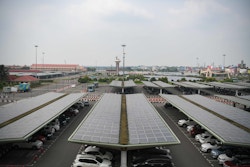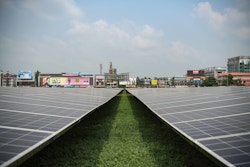India through two lenses: electric and hydrogen
Soon to be the world's most populous country with immense energy challenges, India has set ambitious targets to achieve carbon neutrality by 2070. The development of renewable energies, the electrification of transport, the massive production of green hydrogen: here's an overview of the roadmap of this Asian giant with Beatrice Cordiano, onboard expert in energy and sustainability, during the 75th stopover of our Odyssey.

Energy Observer's arrival in India
Ambitious targets and immense challenges
Each year, a city about the size of London is added to India’s metropolitan population, increasing the number of new buildings, industrial sites and transportation infrastructures. With a population of almost 1.4 billion people, it is expected to overcome China and become the world’s most populous country as of next year.
Sustaining such a fast-growing economy translates into a huge energy demand, which has so far been covered by imports of fossil fuels. Like many other developing countries in South-east Asia, coal and oil have historically served as the backbone of India’s industrialization and development, bringing modern energy services to an increasing number of Indians.
This rapid growth in fossil fuels consumption has led to an increase in the country’s annual CO2 emissions, making it the third largest emitter in the world. Given India’s size and enormous development potential, its energy demand is likely to increase more than any other country in the coming years and so will emissions, if the energy mix aren’t rethought.
Nevertheless, efforts to make India shift from a power deficit to an energy self-sufficient asset have continued for several decades and today more than ever the country is committed to seeking alternative energy sources for a sustainable development. India has set an ambitious target at Glasgow COP26: reach carbon neutrality by 2070. Even more ambitious goals have been announced by Prime Minister Narendra Modi for 2030 to speed up this transition towards low-carbon energy sources: 500 GW of renewable energy capacity to cover 50% and 40% of energy and electricity needs respectively and to reduce total carbon emissions by 1 billion tons.
The will is clear, goals are tremendous, but huge challenges are yet to be overcome. Good news is that the transition to clean energy is already on track and India is betting on its infinite renewable potential to rethink mobility and produce green hydrogen.

G7 Summit 2022 in Germany
The transport sector: a giant to decarbonize

Kochi metro
As an emerging market, India is one of the world's largest manufacturers of cars and two-wheelers. It also has the fourth biggest rail network and the fastest growing aviation market. India’s transport sector needs to cater over a billion people: it keeps on expanding, contributing to congestion and atmospheric pollution. At present, oil is the main source of energy for this sector, the majority being imported. This makes transport the third largest greenhouse gas (GHG) emitter in India, accounting for about 15% of energy-related CO2 emissions. Of all those carbon dioxide emissions, 90% come from the road sector and if people shift away from public to private transport, this figure is likely to worsen. The data are crystal clear; setting a specific road transport decarbonization target is important to help India move closer to its global climate commitment while achieving important co-benefits: cleaner air, a healthier population, and a reduction of its reliance on imported oil.
Decarbonization efforts are palpable in the Kerala region, and in Kochi more than elsewhere in India, with projects like the railway metro, the water metro and electric rikshaws, all powered by electricity coming from solar installations.
India has embarked on very ambitious electrification policies and here the transition to electric mobility is slowly picking up. The country has the potential to become a global actor in the production of Electric Vehicules (EVs), yet only a scale-up of charging infrastructure can increase the uptake of such electric vehicles.

Solar airport Kochi, India
The green hydrogen race
Green hydrogen shaped up to be a central theme at this year's COP27 with early pledges coming from the European Union, Egypt, Namibia, Kenya, Kazakhstan and Oman. A growing number of governments have announced policies, national roadmaps and financial measures that have helped tip the scale towards a green hydrogen revolution. Likewise, India has unveiled its intention to jump on the hydrogen revolution train to decarbonize hard-to-abate sectors and meet its climate targets.
The country plans to produce 5 Mt of green hydrogen - produced via water electrolysis using renewable energy - per year by 2030, with the aim of becoming a hub for production and export of hydrogen. Such an objective, which is half of that of the European Union, will require the deployment of an electrolysis capacity of 25 GW and will undoubtedly boost the pathway towards an increased renewable energy capacity. 5Mt of hydrogen could replace around 11 Mt of natural gas or 25 Mt of coal, thus avoiding about 34 to 57 Mt of CO2 by 2030.

Electric water metro in Kochi, India
If used directly, electricity is undoubtedly a more efficient way of replacing fossil fuels, but direct electrification is not straightforward. It would be, if energy demand and production from renewables where synchronised. That is, however, not the case in the industry and thus not the best solution for some sectors like heavy mobility and steel, cement and ammonia manufacturing. That’s where hydrogen comes into play and why India is betting so much on it.
India has two big assets: ample renewable resources and low electricity generation costs. There is more. When low renewable energy prices couples with the technological development and the scale-up of electrolysing facilities, that’s where a globally competitive hydrogen market becomes possible. In this gigantic country that is India, domestically manufactured hydrogen will help enhance the energy security representing a unique opportunity to participate in energy and commodity trades. Moreover, as fossil fuels become more and more expensive, the competitiveness of renewables increases. The rising pressure on energy security and the inflation triggered by the war in Ukraine are speeding up this cost tipping point even more. This means that the price of green hydrogen will evens out with fossil fuel-based H2, with or without carbon capture, sooner than expected. The final products, such as ammonia or methanol, will also become economically competitive much earlier than anticipated. The opportunities related to green hydrogen are tangible and real, but so are the challenges.

A transition to clean energy is an immense opportunity. India not only has the necessary resources but also has a veritable desire for change. Today it is already on track to become one of the major leaders in renewable energy generation and green hydrogen production, but support from the international community is still needed to help this giant make its transition towards a low-carbon economy.